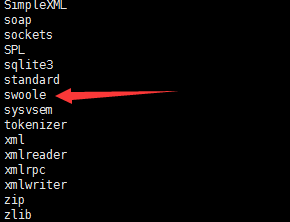版权声明:本文为博主原创文章,遵循 CC 4.0 BY-SA 版权协议,转载请附上原文出处链接和本声明。
本文链接: https://blog.csdn.net/msllws/article/details/84404894
下载Swoole PECL扩展源码包:http://pecl.php.net/package/swoole
关于PHP版本依赖选择:

下载好放到/usr/local/src下,解压缩:
tar -zxvf swoole-2.2.0.tgz
准备扩展安装编译环境:
phpize

查看php-config位置:
find / -name php-config

配置:(--with-php-config==后面是你自己的php-config位置)
./configure --with-php-config=/www/server/php/72/bin/php-config
编译安装:
make && make install

在php.ini里面加一行 :
extension = swoole.so
使用 php -m 命令查看swoole扩展已经安装成功:

查看phpinfo信息:

(测试前说明:以下使用的端口,要确认服务器放行,宝塔环境还需要添加安全组规则)
【创建TCP服务器】
创建server.php:
//创建Server对象,监听 127.0.0.1:9501端口
$serv = new swoole_server( "127.0.0.1", 9501);
//监听连接进入事件
$serv->on( 'connect', function ($serv, $fd) {
echo "Client: Connect.\n";
});
//监听数据接收事件
$serv->on( 'receive', function ($serv, $fd, $from_id, $data) {
$serv->send($fd, "Server: ".$data);
});
//监听连接关闭事件
$serv->on( 'close', function ($serv, $fd) {
echo "Client: Close.\n";
});
//启动服务器
$serv->start();
启动TCP服务:
php server.php
查看9501端口已被监听:
netstat -an | grep 9501

使用telnet连接TCP服务,输入hello,服务器返回hello即测试成功:
telnet 127.0.0.1 9501

(如果telnet工具没有安装,执行yum install telnet 、yum install telnet-server)
也可以写一个TCP客户端连接TCP服务器端:
创建tcp_client.php:
//创建Client对象,监听 127.0.0.1:9501端口
$client = new swoole_client(SWOOLE_SOCK_TCP);
if(!$client->connect( "127.0.0.1" , 9501)){
echo "连接失败";
exit;
}
//向tcp服务器发送消息
fwrite(STDOUT, "请输入:");
$msg = trim(fgets(STDIN));
$client->send($msg);
//接受tcp服务器消息
$result = $client->recv();
echo $result;
启动tcp客户端:
php tcp_client.php
测试结果:

【创建UDP服务器】
创建udp_server.php:
//创建Server对象,监听 127.0.0.1:9502端口,类型为SWOOLE_SOCK_UDP
$serv = new swoole_server( "127.0.0.1", 9502, SWOOLE_PROCESS, SWOOLE_SOCK_UDP);
//监听数据接收事件
$serv->on( 'Packet', function ($serv, $data, $clientInfo) {
$serv->sendto($clientInfo[ 'address'], $clientInfo[ 'port'], "Server ".$data);
var_dump($clientInfo);
});
//启动服务器
$serv->start();
启动UDP服务:
php udp_server.php
查看9502端口已被监听:
netstat -an | grep 9502

使用netcat连接UDP服务,输入hello,服务器返回hello即测试成功(CentOS):
nc -u 127.0.0.1 9502

(如果没有安装netcat监听器,执行yum install -y nc)
【创建Web服务器】
创建http_server.php:
$http = new swoole_http_server( "0.0.0.0", 9501);
//配置静态文件根目录(可选)
$http->set([
'document_root' => '/www/wwwroot/lwsblog',
'enable_static_handler' => true,
]);
$http->on( 'request', function ($request, $response) {
var_dump($request->get, $request->post);
//设置header
$response->header( "Content-Type", "text/html; charset=utf-8");
//设置cookie
$response->cookie( "name", "lws", time()+ 3600);
//发送Http响应体,并结束请求处理。
$response->end( "
Hello Swoole. #".rand( 1000, 9999). "
");});
$http->start();
启动服务:
php http_server.php
(如果9501端口已经被占用查看进程PID,杀死进程:)

lsof -i:9501

kill 9013
浏览器访问主机地址:端口号,得到程序预期结果即测试成功:

【创建WebSocket服务器】
创建ws_server.php:
//创建websocket服务器对象,监听0.0.0.0:9501端口
$ws = new swoole_websocket_server( "0.0.0.0", 9501);
//配置静态文件根目录(可选)
$ws ->set([
'document_root' => '/www/wwwroot/lwsblog',
'enable_static_handler' => true,
]);
//监听WebSocket连接打开事件
$ws->on( 'open', function ($ws, $request) {
var_dump($request->fd, $request->get, $request->server);
$ws->push($request->fd, "hello, welcome\n");
});
//监听WebSocket消息事件
$ws->on( 'message', function ($ws, $frame) {
echo "Message: {$frame->data}\n";
$ws->push($frame->fd, "server: {$frame->data}");
});
//监听WebSocket连接关闭事件
$ws->on( 'close', function ($ws, $fd) {
echo "client-{$fd} is closed\n";
});
$ws->start();
运行程序:(这里还是要确认监听的端口没有被占用,如果被占用查看进程PID,杀死进程)
php ws_server.php
前端页面js监听:(127.0.0.1改成你的主机地址)
<head>
<title>WebSocket </title>
</head>
<body>
</body>

